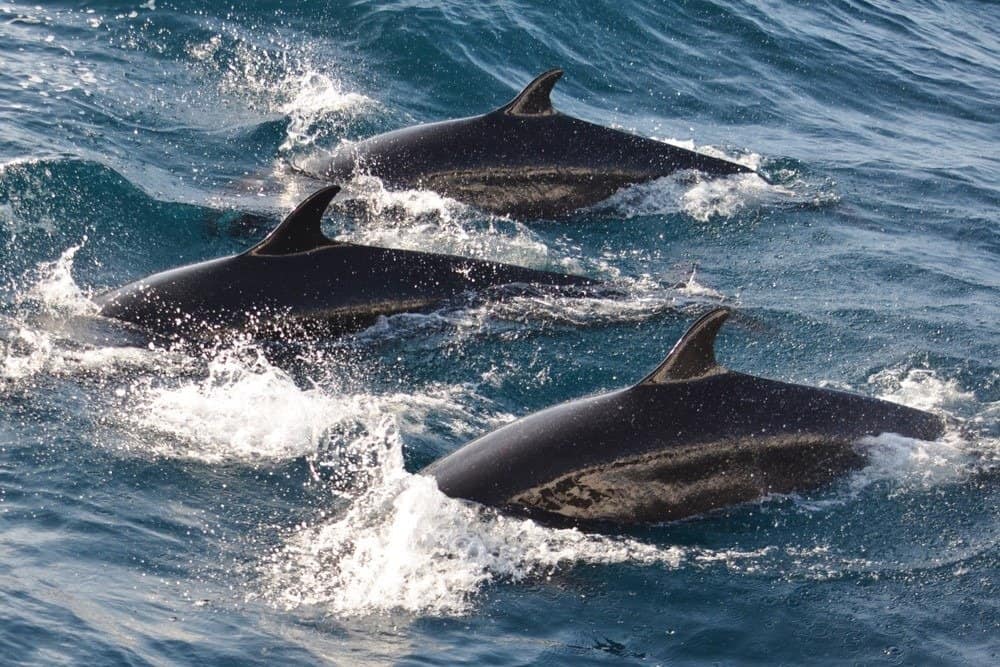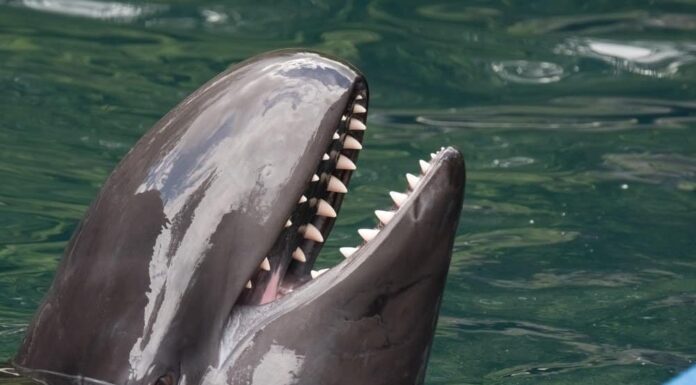The false killer whale is a fast and agile swimmer, a peak predator, and a highly intelligent and social animal.
The name obviously arises from the similarities between orcas and false killer whales. Until 1862, early taxonomists classified both species within the same genus. Despite the name, this species is sometimes mistaken for the bottle-nosed dolphin or short-finned pilot whale. It is now under threat in certain parts of its range.
5 Incredible False Killer Whale Facts!
- The false killer whale is a highly social species that forms pods of up to 500 members, some of which can include oceanic dolphins. These pods sometimes break up into smaller groups of around 10 to 30 while hunting.
- The false killer whale has a diverse range of vocalizations that include whistles, squeals, and a pulsating noise. Although it is not entirely clear what they’re saying, this species has so many different sounds at its disposal that experts have suggested it must be a complex form of communication. It is far more diverse, say, than human sounds.
- One of the more amazing facts of its intelligence is that the false killer whale will ride in the wake of a ship for extra speed and actually leap out over the wake. Very few other animals make this leaping motion in a ship’s wake.
- Large numbers of false killer whales will sometimes become accidentally stranded on beaches, possibly while hunting for food. This can make for a very grim spectacle.
- The false killer whale will sometimes snatch food right out of fishing lines. However, it has also been known to offer food to divers.
False Killer Whale Scientific Name
The scientific name of these animals is Pseudorca crassidens. Pseudorca obviously means pseudo (or false) orca, while crassidens means thick toothed in Latin. The false killer whale is the only currently living member of its genus (although two more species are known from the fossil record). It belongs to the family of Delphinidae, making it closely related to oceanic dolphins and orcas.
Obviously, as a cetacean, this is a type of mammal to its core, because it gives birth to live young and produces milk. The cetaceans actually evolved from hoofed mammals some 50 million years ago. An early cetacean ancestor probably looked like the modern deer-like chevrotain, but the hippos are the closest living relative.
False Killer Whale Appearance
These animals actually looks a bit like a cross between a dolphin (with its rather sleek, ergonomic body) and a killer whale (because of the rounded head with no beak). Nevertheless, you probably wouldn’t mistake them for an orca. The false killer whale has a much smaller dorsal fin and a distinct curved hump on the flippers. And instead of the black and white coloration of the orca, the false killer whale has a black or dark gray coloration with a streak of white along the side. This makes it look more like an oceanic dolphin.
The male of this species measures up to 20 feet long and 3,000 or 4,000 pounds in weight, while the female measures a slightly less formidable 16 feet. This is around the size of a pickup truck.

stefan seiden/Shutterstock.com
False Killer Whale Distribution, Population, and Habitat
These animals have a truly massive territory that graces every continent except for Antarctica. Due to its preference for temperate and warm tropical waters, this species has a natural range that extends around the coasts of Africa, India, the Pacific Asia region (including Australia and New Zealand), the American Pacific Coast as far as Hawaii, the Caribbean Sea, and the Mediterranean. It has also been found as far north as the North Sea around Britain and Norway, China and Japan, Pacific Canada, and Alaska. They typically dive to around 2,000 feet in search of food, but as a mammal it must come up occasionally for air.
Exact population figures are unknown, but local populations in the low tens of thousands have been observed in certain regions such as China and Japan. Despite its wide range, this species is actually near threatened. The biggest threats to its survival are the depletion of prey, injury or death from net entanglements, and environmental pollution. Even though the United States has banned many harmful chemicals, pollution can still travel the world’s currents from other regions. Since this species occupies the top of the food chain, it is exposed to toxins that accumulate at lower levels.
False Killer Whale Predators and Prey
Like many dolphins, these animals feed almost exclusively on fish, squid, and to a lesser extent marine mammals like seals and sea lions. Some of the most common fish prey include yellowfin tuna, perch, salmon, and yellowtail. The false killer whale will attack prey by catching them in its mouth as it swims around at high speeds. It will then shake the prey to death and peel off the skin with its sharp teeth.
The false killer whale has few natural predators in the wild apart from maybe sharks and other killer whales, but calves are mostly defenseless and much more prone to attack. They rely on the protection of their mother and the entire group. Humans do sometimes hunt false killer whales but not in particularly large numbers or on an industrial scale.
False Killer Whale Reproduction and Lifespan
Like many other cetaceans, the false killer whale has a rather complex reproductive cycle that involves long maturation and development times. The breeding season lasts all year long but seems to peak in later winter or early spring, during which time both males and females will have multiple mating partners. After copulation, the female undertakes a long and difficult pregnancy that lasts up to 16 months. It’s no surprise then that she only produces a single calf at a time and does not conceive again for around seven years.
The young calf emerges from the womb with the ability to swim on its own. However, it will stay with its mother for up to two years while it receives protection, tutelage, nutrients from the milk, and valuable survival skills. It takes around eight to 11 years for females to mature and eight to 10 years for males. This development time sets them up for a long and successful life, usually lasting around 60 years in the wild. Females begin to experience menopause between 44 and 55 years of age.
False Killer Whales in Fishing and Cooking
The false killer whale is rarely hunted for food or other resources with a few notable exceptions. In some Japanese villages, people herd them with boats into a bay or on a beach to prevent their escape. People in the eastern tropical Pacific region may also consume their meat.
(Frequently Asked Questions)
Are false killer whales dangerous?
The false killer whale is obviously big and powerful enough to harm a person, but very few actual attacks have ever been reported. The facts remain that they aren’t particularly aggressive except in defense of their pods.
Why is it called a false killer whale?
Based on similarities with the skull, the false killer whale was originally assigned to the genus of Orca by the zoologist John Edward Gray in 1846. Even after it was moved to a separate genus, the idea that it was similar to the killer whale seemed to stick.
How big do false killer whales get?
The false killer whale can grow up to 20 feet and 4,000 pounds.
What is the diet of the false killer whale?
The diet of the false killer whale consists almost exclusively of fish, squid, and marine mammals.
How long do false killer whales live?
If it lives long enough to die of natural causes, then the false killer whale can live about 60 years on average.
What Kingdom do False Killer Whales belong to?
False Killer Whales belong to the Kingdom Animalia.
What phylum do False Killer Whales belong to?
False Killer Whales belong to the phylum Chordata.
What class do False Killer Whales belong to?
False Killer Whales belong to the class Mammalia.
What family do False Killer Whales belong to?
False Killer Whales belong to the family Delphinidae.
What order do False Killer Whales belong to?
False Killer Whales belong to the order Artiodactyla.
What type of covering do False Killer Whales have?
False Killer Whales are covered in Skin.
What type of habitat do False Killer Whales live in?
False Killer Whales live in coastal and deep ocean regions.
In what type of habitat do False Killer Whales live?
False Killer Whales live in coastal and deep ocean regions.
What are some predators of False Killer Whales?
Predators of False Killer Whales include sharks and killer whales.
What is the average litter size for a False Killer Whale?
The average litter size for a False Killer Whale is 1.
What is the scientific name for the False Killer Whale?
The scientific name for the False Killer Whale is Pseudorca crassidens.
What is a distinguishing feature of the False Killer Whale?
False Killer Whales have versatile vocalizations.
What is the biggest threat to the False Killer Whale?
The biggest threat to False Killer Whales is competition with humans for food.
What is another name for the False Killer Whale?
The False Killer Whale is also called the blackfish or false pilot whale.
How many False Killer Whales are left in the world?
The population size of the False Killer Whale is unknown.
What is an interesting fact about False Killer Whales?
The False Killer Whale looks like a cross between a dolphin and an orca!
How fast is a False Killer Whale?
A False Killer Whale can travel at speeds of up to 18 miles per hour.
How do False Killer Whales have babies?
False Killer Whales give birth to live young.
